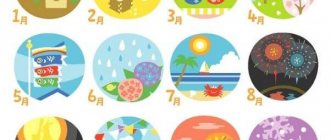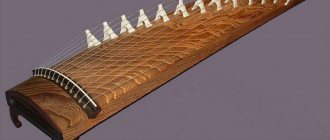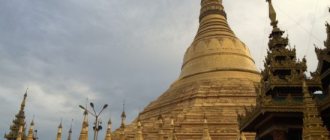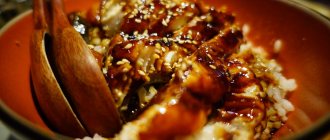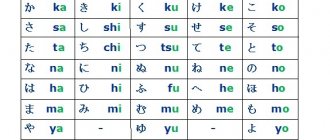The history of the development of Japanese music is clearly divided into several stages, corresponding to important periods of economic and cultural development of Japan. During archaeological excavations on the Japanese islands, an ocarina and a stone whistle were discovered. These instruments date from the Jomon . The use of ceramic vessels as percussion instruments is not excluded. The society of that time is characterized as a society of fishermen, gatherers and hunters, whose spiritual life was dominated by magic. Music, naturally, was part of magical rituals.
During the Choi period , music accompanied funeral rites and agricultural rites. The strengthening of the processes of ethnic unification, assimilation and integration led to the formation of a state during the Confun period (3rd - early 5th century) . Formation of Yamato , the mythological system of Shinto , as well as the folklore mysteries of the Kagura , which synthesized various ritual songs and dances.
The palace musical culture of the medieval states of the continent reflected a different musical level of thinking and was closely connected with Buddhist and Confucian doctrines.
In 710, a special service was formed at the court of the Japanese emperor, in charge of matters of palace ceremonial and accompanying music - gagakuryo . One of the functions of gagakuryo was to introduce the feudal aristocracy to the musical culture of the continent and, first of all, to the palace traditions of medieval states.
With the advent of modern times, almost the entire variety of music of the imperial court was united by the term gagaku . Currently, training in the traditions of gagaku, as one of the types of national musical classics, is carried out at the Tokyo University of Arts and the State Conservatory, and there are societies of gagaku lovers.
In urban culture, along with palace music, modern-style songs performed by professional singers and dancers, entertaining skits, and dengaku , closely related to agricultural rituals, were popular among various segments of the population. During the Ashigaka period (1336-1573), various musical theater traditions began to be synthesized into a unique cultural complex - noh theater. Folklore performances were held at churches and were of an illustrative and narrative nature. After the fall of the Tokugawa shogunate, noh theater became public. At the turn of the 16th-17th centuries. a puppet theater arose.
After the bourgeois Meiji Revolution, an active process of assimilation of European musical culture began, for which traditional institutions were initially used, in particular the gagaku department . However, already in 1872, teaching singing in the European style was introduced in schools, and in 1887 the Tokyo Music School , where teaching was carried out with the help of cultural figures invited from Europe and America. The concert activities of a number of European performers began. , Japanese composers began to become active .
After the end of the First World War, the artistic principles of various European movements were mastered, and elements of traditional Japanese music . The largest organization of Japanese musicians was the Japan League of Contemporary Composers .
After the end of World War II, Japanese musicians rapidly mastered various types of performing and composing techniques. In 1946, the Japan League of Modern Composers . Orchestras and opera troupes were organized, new music schools and colleges were opened, and many small associations of composers arose. Compositions were created in the traditions of European music of the 19th – early. 20th centuries and dodecaphonic technique. In 1955, an electronic music studio opened. Contemporary music festivals have begun.
The main themes in the content of folklore
Japanese folklore is influenced by two religions: Buddhism and Shintoism. The main themes of Japanese legends are supernatural characters, spirits, and animals with magical powers. Also an important part of folklore are instructive stories about gratitude, greed, sad stories, witty parables and humoresques.
The task of art is to worship nature, the task of music is to become part of the surrounding world. Therefore, the composer's thought is not subordinated to the expression of ideas, but to the transmission of states and natural phenomena.
Symbols of Japanese culture
The first association with Japan is sakura (Japanese cherry). The country has a special ceremony for admiring its blossoms - hanami. The tree is repeatedly sung in Japanese haiku poems. Japanese folk songs reflect the similarity of natural phenomena with human life.
Not inferior in popularity to sakura, the crane is a symbol of happiness and longevity. It is not for nothing that the Japanese art of origami (folding paper shapes) has become popular all over the world. Making a crane means attracting good luck. The image of a crane is present in many Japanese songs. Other symbols are also taken from the surrounding world. The symbolism of Japanese culture is natural symbolism.
From time immemorial: traditional Japanese music
In 701, according to the adopted Taiho code, a state body (music administration) was created responsible for the music of the imperial court, whose duties included the study of continental music, primarily Chinese, as well as Japanese folk music, which already existed at that time.
The Taiho Code (大宝律令, “Great Treasure”, the official motto of the reign of Emperor Mommu (701–704) is a collection of laws of the ancient Japanese state of the 8th century from 701, in which the results of the reforms were summarized and consolidated.
Main song and dance genres
Like other nations, Japanese folk music has undergone an evolution from ancient magical forms to secular genres. The formation of most of them was influenced by Buddhist and Confucian teachings. The main classification of Japanese music genres:
- religious music,
- theater music,
- Gagaku court music
- folk everyday songs.
The most ancient genres are considered to be Buddhist chants of shomyo and court music of gagaku. Topics of religious chants: Buddhist doctrine (kada), tenets of teaching (rongi), pilgrimage hymns (goeika), songs of praise (vasan). Shinto music is music to please the gods, short cycles of songs and dances in costumes.
The secular genre includes court orchestral music. Gagaku is an ensemble borrowed from China that performs instrumental (kangen), dance (bugaku) and vocal (uachimono) music.
Japanese folk dances have their origins in ritual performances. The dance involves strange, sudden movements of the arms and legs, and the dancers are characterized by twisted facial expressions. All movements are symbolic and understandable only to initiates.
There are two types of modern Japanese dance: odori, an everyday dance with sharp movements and jumps, and mai, a more lyrical dance that represents a special prayer. The odori style gave rise to kabuki dance, and subsequently the world-famous theater. The Mai style formed the basis of Noh theater.
About 90% of the music of the Land of the Rising Sun is vocal. Important genres of folk music are folk tales, songs accompanied by koto, shamisen and ensembles, and ritual folk songs: wedding, work, holiday, and children's.
The most famous Japanese folk song is the song “Sakura” (that is, “Cherry”):
DOWNLOAD NOTES -
National Japanese music and instruments
The Land of the Rising Sun Japan has a distinctive and unique culture. The heritage of a great nation is closely linked to music. National Japanese music is the same original phenomenon, which was due to the isolation of the country.
The people of Japan always treat the cultural monuments of their homeland with care and respect. Any music is impossible without musical instruments. Japanese musical culture has its own unique genre. This explains the variety of instruments that are used to create musical masterpieces.
Famous musical instruments
One of the most famous Japanese musical instruments is the shamisen , which is similar to the lute. It belongs to the category of three-string plucked instruments. It is derived from sanshin , which in turn is derived from sanxian , which is native to China.
Japanese music and dance cannot do without shamisen, which is still revered in the Japanese islands today and is often used in the Japanese Bunraku and Kabuki theater. It is also important that playing the shamisen is included in the training program for geishas - maiko.
Fue
National Japanese music is also inextricably linked with flutes. The musical instrument fue belongs to the family of flutes, which are known for their high-pitched sound. They are made from bamboo. This flute originated from the Chinese pipe - " paixiao ".
The most famous flue of the fue family is the shakuhachi ,
which is used as a musical instrument by Zen Buddhist monks. According to legend, the shakuhachi was invented by an ordinary peasant. When he was transporting bamboo, he heard a wonderful melody that came from the bamboo when the wind blew into it.
The fue flute, like the shamisen, is often used for accompaniment in the Banraku and Kabuki theaters, and various kinds of ensembles. Some of the fouet can be tuned to the Western style, and thus become soloists. It is interesting that previously playing the fue was characteristic only of Japanese wandering monks.
Suikinkutsu
Another instrument that represents Japanese culture is the suikinkutsu . It has the shape of an inverted jug with water flowing from above. Getting inside through certain holes, it causes the instrument to emit a sound that is very similar to the ringing of a bell. This instrument is played before the tea ceremony, and is also used as an attribute of a traditional Japanese garden.
By the way, for convenience, the tea ceremony can take place in the garden. The sound of the instrument plunges a person into an inexplicable feeling of relaxation and creates a contemplative mood. This state is very suitable for immersion in Zen, since relaxing in the garden during the tea ceremony is part of the Zen tradition.
Taiko
taiko instrument is more understandable to our perception .
which translated into Russian means “drum”. Taiko became famous in military affairs, by the way, just like his counterparts in other countries. As they say, in the chronicles of Gunji Yeshu, nine by nine blows meant a call to battle, and in turn, nine by three meant that the enemy must be pursued.
It is necessary to take into account that during a drummer’s performance, they pay attention to the aesthetics of the performance he offers, since not only the melody and rhythm of the performance are important, but also the appearance of the instrument on which the melody is played.
Genres of Japanese music
Japanese folk music has come a long way in its development. Its origins were magical songs; later, Confucianism and Buddhism influenced the development and formation of the musical genre. Thus, Japanese music is, in one way or another, associated with rituals, traditional holidays, theater performances and other activities. Japanese ethnic music, which in the modern world can be listened to online at any time of the day and anywhere, has become an important part of the country’s cultural heritage.
There are two main, most popular types of national Japanese music.
- The first is shomyo , which is Buddhist chants.
- The second is gagaku , which is orchestral court music.
But there are also genres that do not have ancient roots. These include Yasugi Bushi and Enka.
The most popular genre of Japanese folk songs is yasugi bushi , which is named after the city of Yasugi. The theme of the genre is related to ancient history and mythical and poetic tales. But yasugi bushi is not only songs, but also the dance of the sukui dojo, as well as the art of juggling to the music of zeni daiko , in which bamboo stems filled with coins are used as a musical instrument.
Enka , as a genre, arose relatively recently, in the post-war period. In it, Japanese folk motifs are intertwined with jazz and blues music. Thus, Japanese music has its own national characteristics, and thus differs from other musical genres in other countries. So, there are musical instruments called singing wells, which you will not see anywhere on earth, except perhaps in Tibet.
Japanese music is characterized by constantly changing tempo and rhythm. Often there is no size. Japanese music is close to the sounds of nature, which makes it even more mysterious and unusual.
Video: Japanese music online
Musical instruments
Almost all of the ancestors of Japanese musical instruments were brought to the islands from China or Korea in the 8th century. Performers note only the external similarity of instruments with European and Asian models; in practice, sound production has its own characteristics.
Koto is a Japanese zither, a stringed instrument that represents a dragon. The body of the koto has an elongated shape, and when viewed from the side of the performer, the head of the sacred animal is on the right, and its tail is on the left. The sound is extracted from silk strings using fingertips, which are worn on the thumb, index and middle fingers.
The shamisen is a plucked string instrument similar to a lute. It is used in the traditional Japanese Kabuki theater and is a hallmark of Japanese culture: the colorful sound of the shamisen in ethnic music is as symbolic as the sound of the balalaika in Russian music. The shamisen is the main instrument of traveling goze musicians (17th century).
Shakuhachi is a Japanese bamboo flute, one of the representatives of a group of wind instruments called fue. Producing sound on a shakuhachi depends not only on the air flow, but also on a certain angle of inclination of the instrument. The Japanese tend to animate objects, and musical instruments are no exception. It can take several months to tame a shakuhachi spirit.
Taiko - drum. The tool was indispensable in military operations. A certain series of taiko strikes had its own symbolism. Drumming is spectacular: in Japan, both the musical and theatrical aspects of performance are important.
Singing bowls are a feature of Japanese musical instruments. There are almost no analogues anywhere. The sound of Japanese bowls has healing properties.
Singing wells (suikinkutsu) are another unique instrument that consists of an inverted jug buried in the ground with water placed above it. Through a hole in the bottom, the drops enter and make sounds reminiscent of a bell.
Shomyo
Another ancient form of traditional Japanese music is one of the oldest existing forms of vocals - shomyo (声明), where the character 声 means “sound, voice”, the character 明 means “clear, light”.
Shomyo is a style of throat singing used by Buddhist monks to perform sacred texts. Sung a cappella (without instrumental accompaniment) by one or more performers.
Shomyo chants can be accompanied by two instruments for beating rhythm during ceremonies and prayers: the mokugyo (“wooden fish”), a wooden drum in the shape of a fish, and the uchiwa-daiko, a drum with a wooden handle.
This genre came from India, through China to Japan, where it quickly spread and adapted to local musical styles. The genre developed through missions to China, which ended in 894. Then Japanese shomyo broke away from the Chinese model and underwent its own evolution. Shomyo is most popular in the Tendai and Shingon Buddhist schools.
Style features of Japanese music
The modal structure of Japanese music is fundamentally different from the European system. The basis is a scale of 3, 5 or 7 tones. The mode is not major or minor. The intonation in Japanese folk music is unusual to the European ear. Pieces may not have a regular rhythmic organization - meter, rhythm and tempo often change. The structure of vocal music is guided not by the pulse, but by the breath of the performer. This is why it is well suited for meditation.
The lack of musical notation is another feature of Japanese music. Before the Meiji era (i.e. before the arrival of the European recording model in the country), there was a system of notations in the form of lines, figures, and signs. They symbolized the desired string, fingering, tempo and character of the performance. Specific notes and rhythm were not prescribed, and the melody was impossible to play without knowing it in advance. Due to the oral transmission of folklore from generation to generation, much knowledge was lost.
A minimum of dynamic contrasts is a stylistic feature that distinguishes Japanese music. There are no sharp transitions from forte to piano. Moderation and slight variations in dynamics make it possible to achieve expressiveness characteristic of the East. The climax in Japanese tradition occurs at the end of the play.
Japanese music during the war and post-war years
Since 1941, Western music has been performed mainly by the Tokyo Symphony Orchestra . In 1945 it was renamed the Toho Symphony Orchestra , the New Symphony Orchestra became the NHK (Japan Broadcasting Corporation) Orchestra, and many other symphonies began to appear.
There is also a movement of Roon workers to introduce the working people to musical culture.
Japanese composers of this time, when composing operas, took Japanese tales and Buddhist legends as a basis.
In 1951, an electronic music studio opened at NHK.
The Japan Contemporary Music Association , which existed before the war under other names and organized festivals every year, the Association of Contemporary Composers (1946), Shinseikai (1946), Chijinkai (1948) and the experimental studio Jikken Kobokai (1949) were created
In the 60s group, the Ongaku and New Direction groups appeared, advocating improvisation, but many groups composed music for the Nipponia Orchestra, consisting of traditional instruments.
Foreign musicians began to visit Japan again from the mid-1950s, and Japanese musicians and composers also became famous abroad.
Currently, Western music is thriving in Japan. Teaching, performance, musical literature, instrument making - all this is now not inferior to Europe. There are six symphony orchestras in Tokyo, and all types of Western music are performed and composed in Japan, from Renaissance and Baroque music to jazz, rock and other contemporary styles. The confrontation between Western and traditional music remains, but is not expressed as clearly as it was before.


